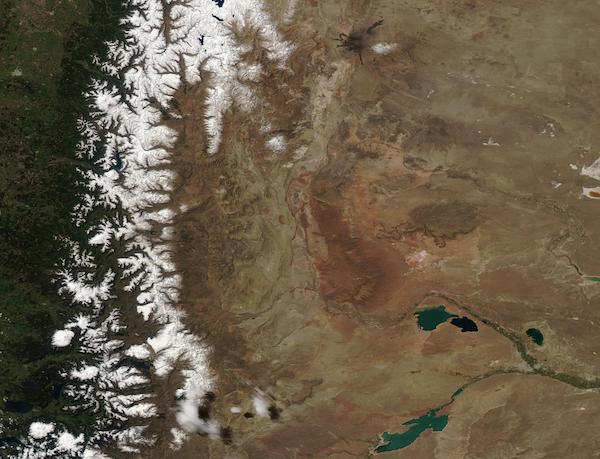Images
October 15, 2020 - Springtime Snow in the Andes
Tweet
On October 13, 2020, the Moderate Resolution Imaging Spectroradiometer (MODIS) on board NASA’s Aqua satellite acquired a true-color image of snow capping the Central Andes of Chile and Argentina. The border between the two countries courses the peaks of the rugged mountain range with Chile in the west and Argentina in the east.
Springtime in the Central Andes, like spring in most places, is a time of increasing warmth, lengthening sunshine, change, and rebirth. Wildflowers begin to bloom, birds take flight in migration that may carry them thousands of miles to breeding grounds, and soon various mammals, including a llama-like species known as guanaco, begin to give birth.
The longer days and increasing temperatures also begin to melt the winter’s snowfall. Not all of the snow will melt, as many of the higher peaks retain glaciers and snow year-round. Snowpack that accumulates in the mountains is the primary source of water for communities at lower altitudes. The water is used for city water supplies, power generation, and agriculture.
Snowpack is particularly critical for the more arid regions of east of the tall Andean peaks. Several large reservoirs can be seen in the southeast section of the image (lower right). Sitting in Neuquén Province, Argentina, these large impoundments collect water from rivers that begin in the high Andes Mountains. Water from the Neuquén River fills the pair of round lakes, the Los Barreales Reservoir (west) and the Mari Menuco Reservoir, as well as Pelligrini Lake (east). The Limay River contributes to the long Ezekiel Ramos Mexia Reservoir in the south. The source of the Limay, Nahuel Huapi Lake, sits about 2,500 feet (760 meters) above sea level, while the streams that ultimately form the Neuquén River begin at about 7,500 feet (2,300 meters) above sea level.
Image Facts
Satellite:
Aqua
Date Acquired: 10/13/2020
Resolutions:
1km (45.1 KB), 500m (157.4 KB), 250m (481.9 KB)
Bands Used: 1,4,3
Image Credit:
MODIS Land Rapid Response Team, NASA GSFC
Tweet
On October 13, 2020, the Moderate Resolution Imaging Spectroradiometer (MODIS) on board NASA’s Aqua satellite acquired a true-color image of snow capping the Central Andes of Chile and Argentina. The border between the two countries courses the peaks of the rugged mountain range with Chile in the west and Argentina in the east.
Springtime in the Central Andes, like spring in most places, is a time of increasing warmth, lengthening sunshine, change, and rebirth. Wildflowers begin to bloom, birds take flight in migration that may carry them thousands of miles to breeding grounds, and soon various mammals, including a llama-like species known as guanaco, begin to give birth.
The longer days and increasing temperatures also begin to melt the winter’s snowfall. Not all of the snow will melt, as many of the higher peaks retain glaciers and snow year-round. Snowpack that accumulates in the mountains is the primary source of water for communities at lower altitudes. The water is used for city water supplies, power generation, and agriculture.
Snowpack is particularly critical for the more arid regions of east of the tall Andean peaks. Several large reservoirs can be seen in the southeast section of the image (lower right). Sitting in Neuquén Province, Argentina, these large impoundments collect water from rivers that begin in the high Andes Mountains. Water from the Neuquén River fills the pair of round lakes, the Los Barreales Reservoir (west) and the Mari Menuco Reservoir, as well as Pelligrini Lake (east). The Limay River contributes to the long Ezekiel Ramos Mexia Reservoir in the south. The source of the Limay, Nahuel Huapi Lake, sits about 2,500 feet (760 meters) above sea level, while the streams that ultimately form the Neuquén River begin at about 7,500 feet (2,300 meters) above sea level.
Image Facts
Satellite:
Aqua
Date Acquired: 10/13/2020
Resolutions:
1km (45.1 KB), 500m (157.4 KB), 250m (481.9 KB)
Bands Used: 1,4,3
Image Credit:
MODIS Land Rapid Response Team, NASA GSFC




